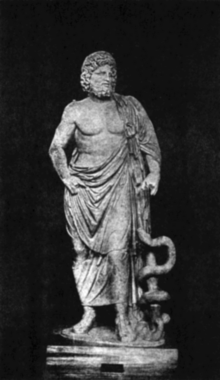
A health deity is a god or goddess in mythology or religion associated with health, healing and wellbeing. They may also be related to childbirth or Mother Goddesses. They are a common feature of polytheistic religions.

A health deity is a god or goddess in mythology or religion associated with health, healing and wellbeing. They may also be related to childbirth or Mother Goddesses. They are a common feature of polytheistic religions.
|
Main article: List of Philippine mythological figures |

According to the Gospels, Jesus performed miracles during his earthly life as he traveled through Galilee, Judea, and Jerusalem. The miracles performed by Jesus are mentioned in two sections of the Qur'an (Sura 3:49 and 5: 110) in general, with few details or comments.[17] One of the greatest miracles Jesus performed was healing (Blind, Leprous, Paralytic, Epileptic, Healing a Bleeding Woman, etc.),[18] the Gospels provide different amounts of detail for each episode, at other times he uses materials such as spit and mud. In general, they are mentioned in the Synoptic Gospels, but not in the Gospel of John.[19][20][21] Luke, one of the apostles, was a physician (Greek for "one who heals").[22]
Jesus endorsed the use of the medical assistance of the time (medicines of oil and wine) when he told the parable of the Good Samaritan (Luke 10:25–37), who "bound up [an injured man's] wounds, pouring on oil and wine" (verse 34) as a physician would. Jesus then told the doubting teacher of the law (who had elicited this parable by his self-justifying question, "And who is my neighbor?" in verse 29) to "go, and do likewise" in loving others with whom he would never ordinarily associate (verse 37).[23]
In 1936, Ludwig Bieler argued that Jesus was stylized in the New Testament in the image of the "divine man" (Greek: theios aner), which was widespread in antiquity. It is said that many of the famous rulers and elders of the time had divine healing powers.[24]